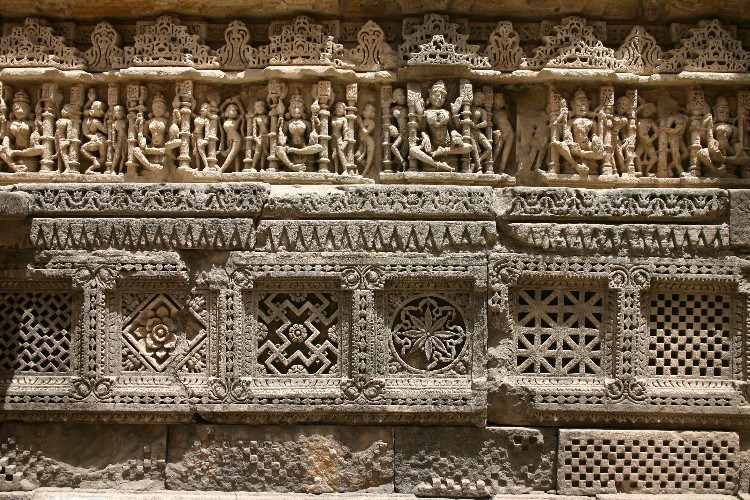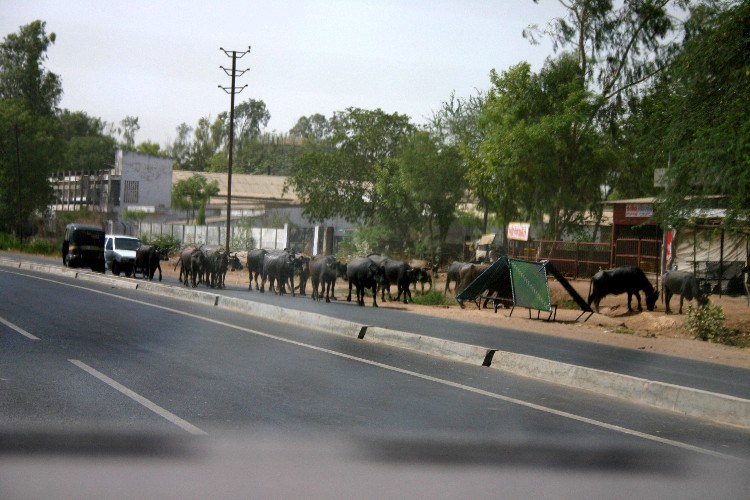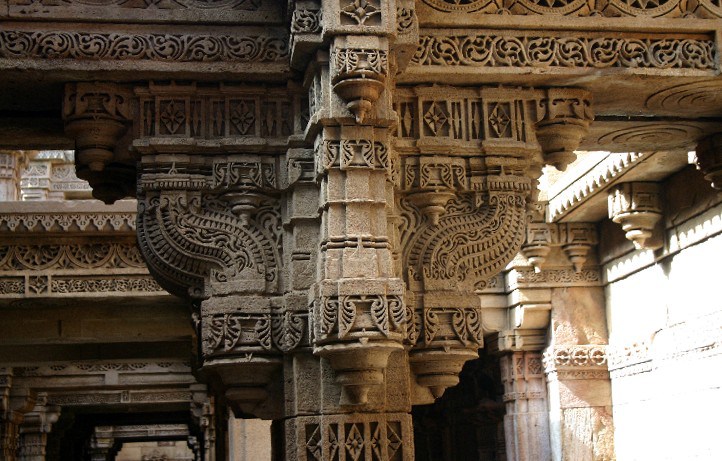When we were in Mumbai, and told people there that we were coming to Ahmedabad,
they all, universally, asked, “why?” Ahmedabad is famous for its textiles – we have been told many times since arriving that it was the “Manchester of India”. Gandhi is in part responsible for this – he helped organize the textile workers of Gujarat, his home state, as part of his campaign to rid India of the British. The 5th largest city in India, with a population of about 5 million (in Gujarat, the only dry state left in India, with a population of about 53 million), Ahmedabad City is a big, industrial place – well off the beaten tourist track and not pretty. The fact of the matter is that we have no idea why we are here – when we told the company that organized our tour of India that we wanted to go to Udaipur and Jaisalmer, we were presented with an either-or proposition: Jaisalmer and Jodhpur; or Udaipur and Ahmedabad. We wanted Udaipur more than Jaisalmer, and so we are in Ahmedabad.
No Regrets: Three Spectacular Sites
But after our 1st day touring some places to visit in Ahmedabad, we have absolutely no regrets about being here. We visit 3 spectacular sites (and sights) today and see parts of India that very few tourists ever get to – as our guide said, we saw “the real India” – and our hotel here is wonderful, quiet, calm, beautiful, a real sanctuary from the real India outside.
First is the Sun Temple, 2 hours north of Ahmedabad in Modhera. Built in the 11th century, it is in amazing condition. Frances, our guide (from Goa, and thus with a Portugese name) tells us that the temple is laid out so that when the sun rises on the equinoxes, it will strike the wall of the sanctuary. The carving throughout is exquisite. He says that the human level (like many traditional Hindu temples, there is a hierarchy of levels throughout the carving – demon below animal below human below god) is all about sex education. And despite a millennium of exposure to weather, war, earthquakes, and air pollution, the graphic details are there.
John and His New Friends at the Rani-ki-Vav
There is a group of schoolchildren and their teachers visiting the Sun Temple, celebrating the end of the school year. They mob Greg and me – they want to shake our hands, say a few words and get our autograph. Our guide later tells us that they are from a small village not too far away, a village where non-Indians almost never go. Second is the Rani-ki-Vav, a step temple built at about the same time as the Sun Temple, and not too far away. Step wells are multi-level affairs, all with a spring-fed pool on the lowest level, designed to be refuges for Queens from the intense heat of the Gujarati summer. Rani-ki-Vav was discovered only in the last 30 years, having silted up over the years. Again, we are overwhelmed by the beauty of the place, and the quality of the carving. From Rani-ki-Vav it is a short drive to Anhilawada Patan, the capital of Gujarata until Ahmed Shah moved the capital to his new city of Ahmedabad in 1411, and the reason that both the Sun Temple and Rani-ki-Vav are located here. Nearby Patan looks and feels and smells like a city that has not changed much since the middle ages. More than anywhere else today (and there are lots everywhere else today – even on the toll motorway we take from Ahmedabad to Mehsana), there are cattle, water buffalo, camels, goats, dogs and the occasional cat in the streets. The only animals that are missing that we’ve seen elsewhere on the streets here in India are elephants and monkeys.
A Patola in Patan
In Patan there is a patola – a traditional silk loom where the threads are dyed in a most amazing way with vegetable dyes while tied in long bundles – maybe 2 metres long by the width of your little finger. They are then put onto the loom and woven, and the colours in both directions match so that the design is the same on both sides. The process is amazing to see – and the quality magnificent: it takes about 4 months to weave a panel of about 3 metres x 1.5 metres. Handed down as a trade from father to son, there is now only this 1 family in all of India doing it, down from 800 families 50 years ago. We stop for lunch just outside the town of Mehsana at a restaurant that Frances says is delicious (it is) and “hygienic” (we can’t say for sure, the dishwashing process left a bit to be desired). We are the only non-Indians for miles around, and all of the families in the restaurant stop eating as we enter. From then until we get into the car, the children shyly come up to us, politely introduce themselves and ask where we are from, while their parents, equally shy, encourage them with hand gestures.
Another Beautiful Step Well in Adalaj Vav
Third is the Adalaj Vav, another stepwell, just outside Ahmedabad. Built in the late 1400s, it has survived pretty much intact since then, although until recently it was used by the villagers to wash their clothes and as a well, and as a bathhouse for the women. And for the 3rd time today, we are overwhelmed by the beauty and skill on display.















Comments